Petroselinum crispum
Wouldn’t you love to add the flavor of garden-fresh herbs to your hearty cold-weather dishes?
Well, there’s no need to rue(!) the arrival of cold weather, because a few of our favorite kitchen seasonings, like parsley, are cold hardy and continue to grow year-round.
Easy to overwinter in many regions, parsley produces crisp, fresh leaves at a slow but steady pace in cool temperatures.
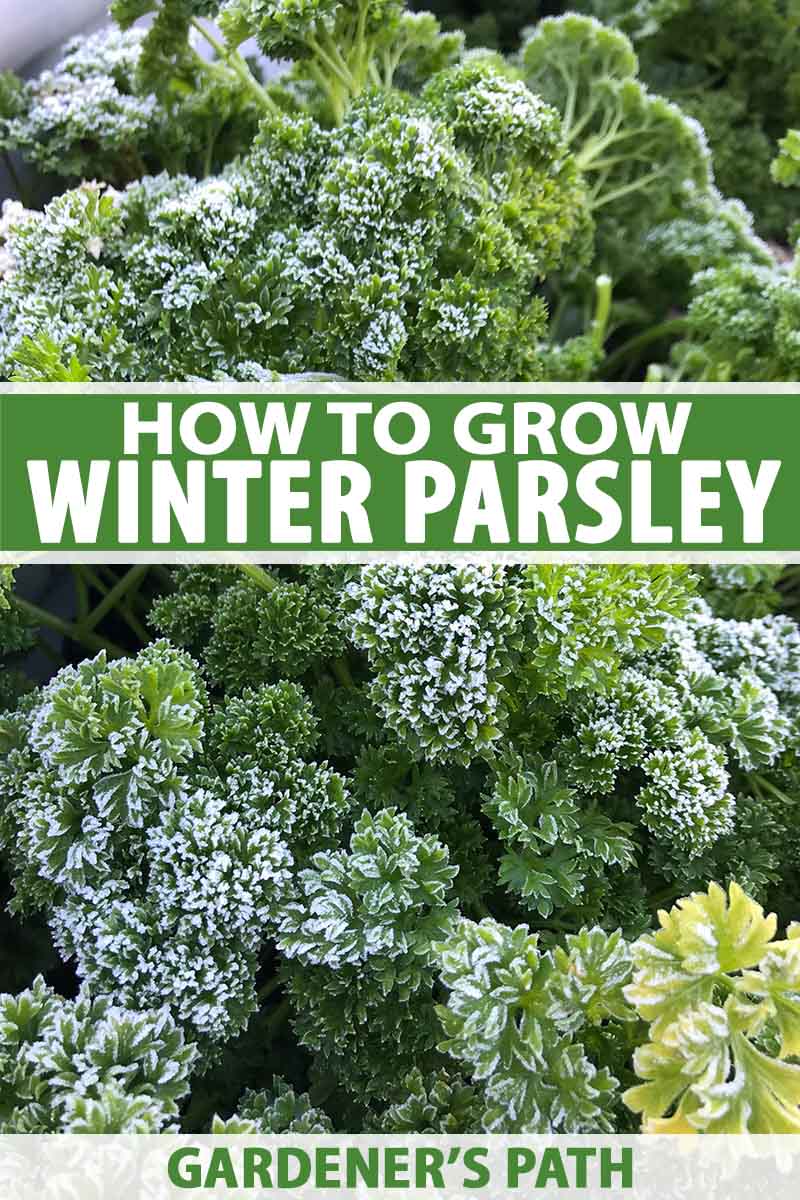
We link to vendors to help you find relevant products. If you buy from one of our links, we may earn a commission.
One of the most commonly grown kitchen herbs, it’s a favorite ingredient in recipes ranging from baked goods to savory dishes and smoothies. And of course, it’s renowned as a pretty and practical garnish!
Being biennial, it’s a natural at surviving the winter. So, whether you grow some in a pot, a protected spot in the garden, or even on a sunny windowsill indoors, you can enjoy its tasty leaves throughout the year.
Join us now for a look at how you can enjoy the garden-fresh taste of parsley all year long!
What You’ll Learn
Parsley Basics
A widely cultivated kitchen herb, parsley rewards with fast growth and an abundance of fragrant, lacy foliage.
A hardworking companion plant, its presence is welcome throughout the garden as a natural pest repellent. And its pretty foliage makes an attractive addition to beds, borders, and containers as well!
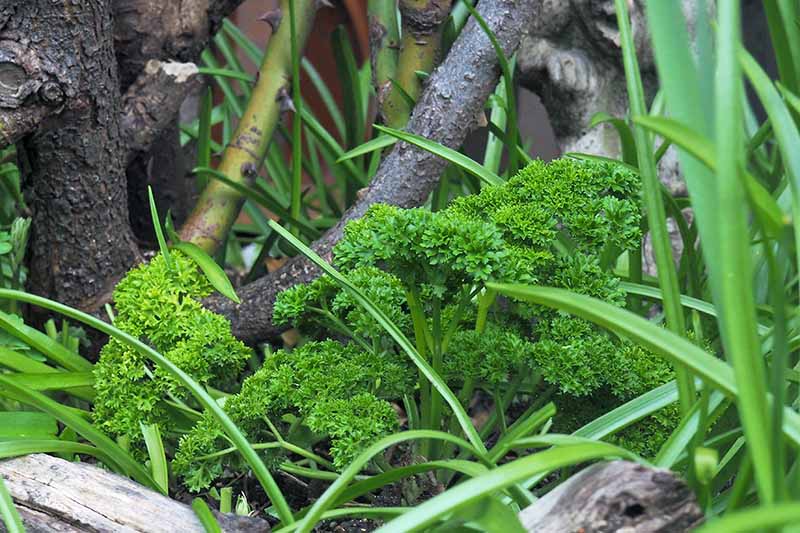
Popular in innumerable recipes, it’s a favorite seasoning in casseroles, eggs, tomato dishes, sauces, soups, stews, and much more. And with its fresh flavor and healthy nutritional profile, it makes a smart addition to green salads and smoothies as well.
Native to the Mediterranean and southern Europe, this member of the Apiaceae family offers two main varieties for the home garden – Italian, aka flat leaf, and curly leaf. There’s also a third variety, Hamburg rooting, which is grown for its large, edible root.
A hardy biennial, it’s typically grown as an annual. However, because of its two-year life cycle, parsley readily overwinters in USDA Hardiness Zones 7 and warmer.
Production is slower in cold temperatures, but leaves continue to grow – even with a light blanket of snow on the ground.
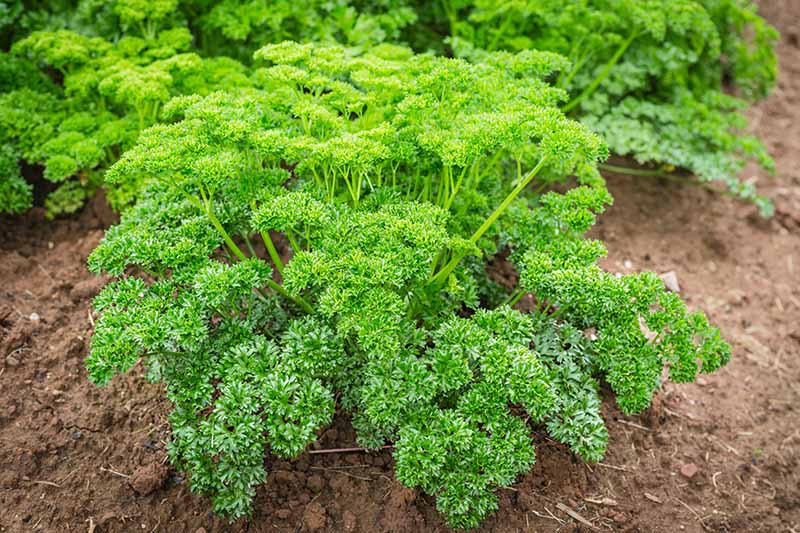
Leaves remain harvestable until the thermometer dips into the low 20s, when freezing can result in leaf loss. But plants are hardy to around 10°F and rebound readily, sending up new shoots with the arrival of longer days, and warmer temperatures.
This means you can enjoy them for over a full year – spring, summer, fall, winter, and spring again!
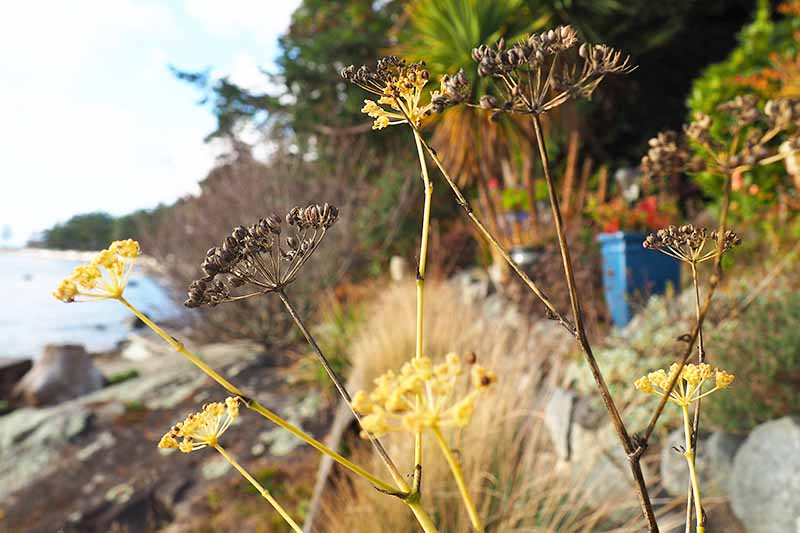
But once flowers are set, the flavor declines and leaf production slows, then stops – their life cycle complete. You can read more about how to grow parsley in this guide.
Growing Tips
Here are a few tips to get the most out of your cold weather harvest:
- Parsley easily grows from seed.
- Always harvest outer leaves first.
- Never pick more than 1/3 of a plant’s leaves at any one time– they supply energy to the roots.
- Extend the plant’s life (a little) by promptly removing flower stalks.
- In areas with high amounts of cold rainfall, pots must have excellent drainage. Remove saucers and place containers directly on the ground so they’re not sitting in water.
- Parsley self-seeds with abandon. Leave a plant or two to flower and set seed – you’ll always have a steady supply of seedlings for the garden or containers.
In the Garden
To overwinter your plants, choose a site that’s sheltered from drying winds, with full sun exposure.
At planting, enrich the soil with generous amounts of organic matter such as compost or aged manure to ensure strong plants.
Protect the roots and crown with a thick collar of straw mulch. This helps the roots stay moist and provides protection from freezing and thawing cycles – when they’re most likely to be damaged.
In early September, encourage new foliage by cutting back plants. Here’s how to do it:
1. Remove up to 1/3 of the longer stems from the outer edge of the plant. This allows more sunlight to enter the center of the plant where new growth emerges.
2, Leave 1 to 2 inches intact at the base of stems you’ve cut to promote new side shoots.
3. When nature doesn’t provide enough moisture, water lightly in the mornings – and only when temperatures are above freezing.
4. Plants that are being harvested will also benefit from regular applications of fertilizer, but only at half strength. A monthly feeding of diluted fish fertilizer or a water soluble, all-purpose formula, such as NPK 5-10-5, will provide necessary nutrients.
To keep leaves viable in freezing temperatures, you may wish to provide a protective cloche to cover the plants.
Outdoor Containers and Pots
For outdoor containers, move them to a protected location where they’ll receive maximum light exposure. Place containers in corners, against a fence or foundation, or nestled under deciduous shrubs and trees.
Provide a thick top mulch of 3-4 inches over the container’s entire surface. Protect roots from freezing by wrapping pots with bubble wrap, or insulate containers with layers of pine boughs or straw.
Water only when the top inch of soil is dry, and feed monthly with a half-strength dose of fertilizer.
Provide cloche protection when frost threatens.
In areas with high winter rainfall, remove saucers or trays from under pots to prevent them from sitting in water.
Indoor Containers
In Zones 6 and colder, you can dig up some plants and bring them indoors in pots or containers.
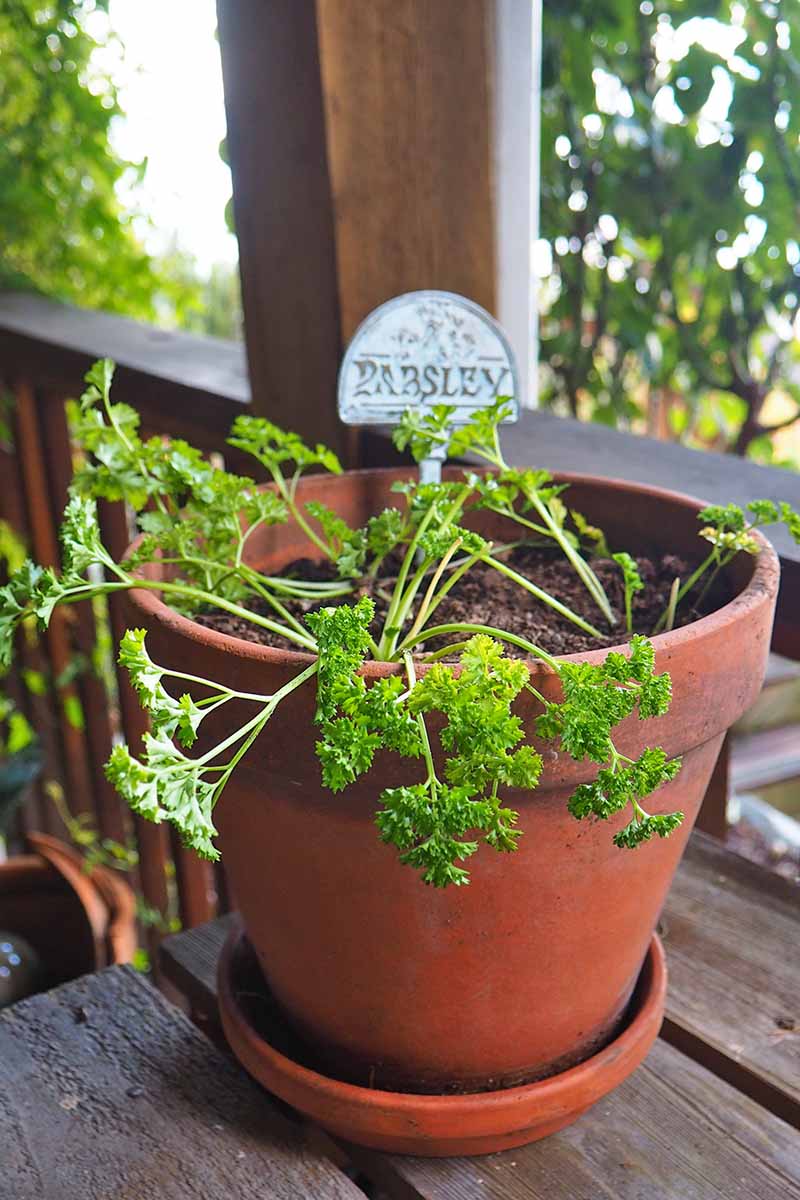
Carefully dig them up and ensure most of the long taproot is intact.
Use containers deep enough to accommodate the roots, and ensure pots have drainage holes and a thick layer of seepage material. Use a light, rich potting soil.
After setting in pots, water well and tuck into a lightly shaded spot for a few weeks to recover from the transplant.
Before a freeze, bring pots indoors and place on a cool, sunny window. With adequate light, plants can last through fall and winter, and will slowly produce new leaves.
Water lightly when the top inch of soil is dry, and fertilize monthly with a diluted fertilizer.
Leaf quality decreases as the plant’s life cycle comes to an end, and by late winter, plants can go into the compost bin.
Get more tips on growing parsley in containers here.
Cultivars to Select
Most parsley – with a bit of care – will be able to survive the winter, here are a couple of our favorites:
Double Curled
Probably the most frost tolerant of all, this cultivar has dark green leaves with tight curls.
The ‘Double Curled’ variety is a vigorous grower, and will provide you with a reliable harvest whatever the weather! Packets of 640 organic seeds are available from Burpee.
Gigante D’Italia
‘Gigante D’Italia’ is a flat leaf, Italian heirloom variety.
A hardy, vigorous grower with thick stalks, the plain flat leaves have a strong flavor. Packets of 800 seeds are available from Burpee.
Enjoy Crispy, Fresh Sprigs All Year
Garden-fresh parsley has an amazing taste – and you can enjoy the crispy leaves all year long!
This cold-hardy biennial enjoys cool temperatures, with just a bit of help to keep it happy.

Outdoors, provide an insulating mulch to protect the roots. And add a cloche in freezing temperatures to keep Jack Frost from nipping at the leaves.
Inside, a cool, sunny window works well for potted plants.
Do you folks have any tips for growing winter parsley? Let us know in the comments below.
And be sure to read some of our other cold weather growing guides for fresh produce all year long! Here are a few that might interest you.
- How to Grow Winter Cabbage for a Late-Season Harvest
- 6 Best Types of Kale for Cold Climates
- How to Store Carrots in the Ground
Photos by Lorna Kring © Ask the Experts, LLC. ALL RIGHTS RESERVED. See our TOS for more details. Product photos via Burpee and Eden Brothers. Uncredited photos: Shutterstock. Additional writing and editing by Clare Groom and Allison Sidhu.

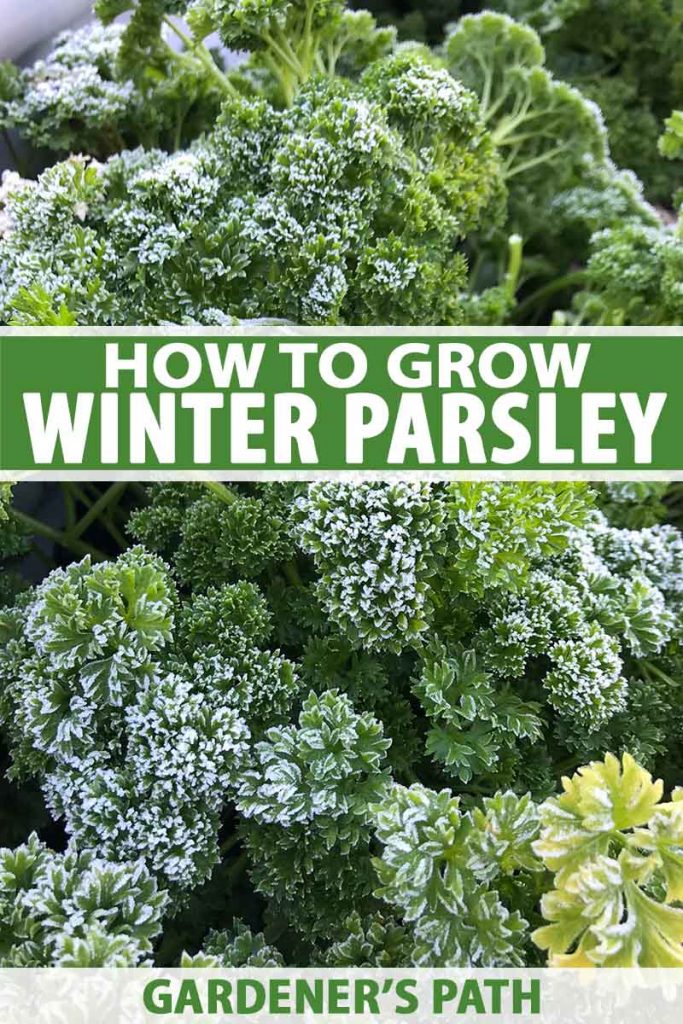
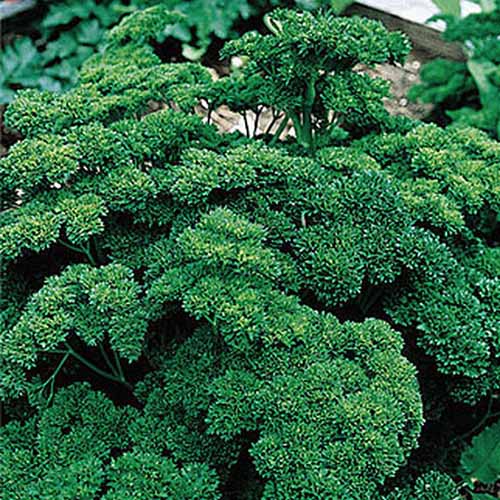
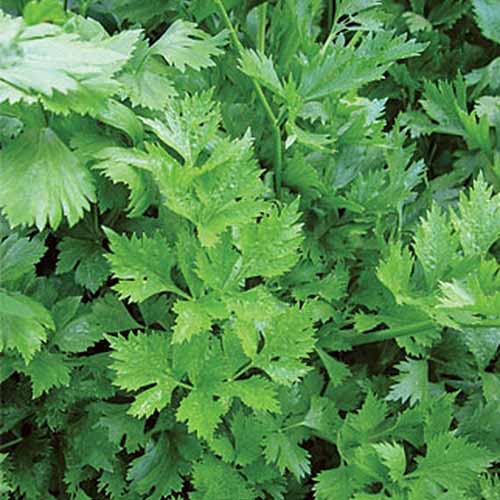
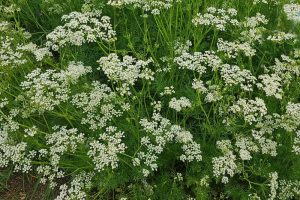

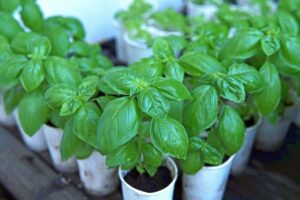
I was so excited that both my rosemary and parsley have kept growing into the winter! I hope they can keep growing into this growing season ????
I’m on the coast in Mississippi will parsley make it trough the summer heat.
Hey Maria: According to the LSU College of Agriculture, in your region parsley is grown as an annual from October to May – because of the heat.
But, they also say it can be grown in summer provided it has afternoon shade – four hours of morning sunlight, then shade. Also, a thick (two to four inches) straw mulch will help retain moisture and keep roots cool in the hotter months.
Thanks for asking!